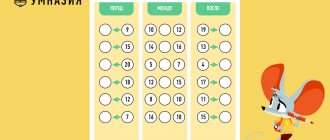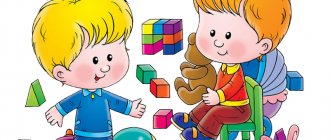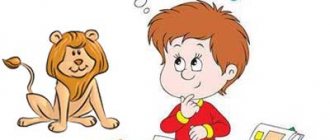Today I would like to talk about the very first games for teaching reading. They are suitable, first of all, for children who still cannot read at all ( you can play from 1.5-2 years old ), but, of course, they will also be useful for those who have already learned a little continuous reading.
I want to say right away that there will be no games here like coloring and modeling all the letters of the alphabet in turn from plasticine. In my previous article, I already wrote that a child who has memorized individual letters using the alphabet or in any other way subsequently experiences many difficulties in combining them into syllables. Therefore, I want to invite you to play not with letters, but immediately with words (MI, BUT, TU...) and short words. With this approach, the child constantly sees ready-made letter combinations before his eyes, plays with them, rearranges them, and, as a result, quickly remembers them . At first, only visually, then he tries to reproduce it himself. As a result, the child does not experience problems with merging letters; he immediately reads the letter. But, interestingly, during such games the child remembers all the letters.
How to understand when it's time
To the question “When is it time for a child to learn to read?” There is no ready answer, but we would like to immediately warn against two misconceptions:
- “You don’t have to teach your child to read at home; they will teach you at school anyway.” Alas, they won’t teach - school teachers simply don’t have time to teach every child to read correctly. Already in the first lessons you will have to read books, textbooks, and inscriptions on the board. Not being able to read, a first-grader risks immediately falling behind his classmates and losing interest in learning.
- “There is no time to waste - the sooner the baby starts reading, the better.” All children are different and develop at their own pace. Therefore, you should not impose learning to read on a preschooler as soon as he is 4–5 years old, if the student himself does not yet show interest in this activity.
The indicator that you should focus on is not the age of the preschooler, but his speech skills.
It's time to learn to read if...
If a preschooler has already developed a sufficient vocabulary to chat with adults, if he constructs sentences grammatically correctly, understands and uses phraseological units in his speech, then the child is ready to learn to read.
Without a sufficient grammatical foundation and vocabulary, learning to read will be difficult. It is critical that the child understands the meaning of the words and phrases he reads, otherwise learning will not be productive. Therefore, if the child is not yet very confident in speaking, do not rush him into reading - this will not help develop speech, but will only demotivate him.
How to make learning to read easier for a preschooler
Praise more and never scold
It’s hard for us adults to imagine how difficult it really is for a child to learn such a complex skill as reading from scratch. After all, to be able to read means to be able to correlate a sound with a letter or combination of letters, to understand the meanings of the words read and the meaning behind the text.
If parents take the child's successes for granted and express dissatisfaction when the child does not understand something, this will not push the student to develop, but will only complicate the process. Therefore, it is important to praise for small victories: I learned the letter that we studied last time - great, I coped with a word with as many as two syllables without my dad's help - smart girl.
Do not perceive failures as a consequence of the little student’s negligence. When a child does not understand the first time, this is a reason to look for another explanation or give more time to practice. If you feel tired and irritated, you should stop the activity and return to it in a good mood.
Exercise little by little but regularly
You shouldn’t expect your child to be perseverant and willing to spend hours figuring out unfamiliar letters. It is difficult for preschoolers to maintain attention in a lesson for longer than 25 minutes, and even such small lessons should be interrupted with physical education and games so that the child does not get bored. This is exactly how preparation for school is structured at Skysmart: 25-minute classes with breaks for outdoor games.
But regular practice is important - much more important than the duration of the lesson. And these don’t have to be just lessons: you can look for familiar letters on signs while walking, on a door sign in a children’s clinic, on the packaging of your favorite corn flakes.
Read books aloud
In a series of studies conducted by Dr Victoria Purcell-Gates on five-year-olds who were not yet able to read, it was found that those children who were regularly read aloud by their parents for two years expressed ideas in more literary language, constructed longer sentences and used more complex syntax .
In addition, reading aloud with adults helped expand children's vocabulary, as parents explained the meaning of new words that children had not encountered in everyday life.
Expert opinion
According to neuroscientist Marianne Wolfe, evenings spent reading with parents help foster a love of reading because children develop a connection between reading aloud and feelings of love and warmth.
Discuss what you read
The role of communication in teaching literacy is difficult to overestimate. At first, it is important to ask if the student is interested, if he is tired, and what he remembers from the lesson. When a preschooler learns to read coherent texts, be sure to ask questions about their content.
It’s great if a child reads independently and without parental encouragement, but even in this case, do not deprive him of the opportunity to discuss what he read with you. For example, you could ask:
- Who was your favorite character?
- Do you think this heroine is like you? Would you like to be like her?
- What would you do if you were the hero?
- Why did the described event happen? How are these two events related?
- How did what you read make you feel?
- What do you remember most from what you read?
- What do you think the author wanted to teach? Why did he write this? Do you agree with the author?
Go from simple to complex
From the correspondence between sounds and letters - to syllables, from short words - to longer and more complex words. It would seem that this is obvious, but no: sometimes parents are so happy with the child’s success at first that they push him to study more complex topics than he is ready to accept. Of course, the program should be tailored to the student, but you should not skip steps, even if the child is making progress.
There are methods that suggest teaching a child to read by memorizing whole words. Unfortunately, experiments show that such methods generally work worse. For example, a group of scientists from the United States came up with an artificial alphabet and asked subjects to learn it, and then read words written using this alphabet. At the same time, some subjects were immediately explained the principles of correspondence between sounds and letters, while others had to deduce the rules of reading on their own based on whole words. It turned out that the first group copes with reading new, previously unfamiliar words better than the second.
Therefore, we advise you to choose teaching methods that provide clear instructions about the connection between sounds and letters - and this is especially important for those children for whom reading is difficult. Below we have collected several such techniques that you can use to homeschool your preschooler.
Basic principles of games
There is one very sure way to discourage a child from reading - this is to constantly test him: “Tell me, what letter is this?”, “Read what is written here!” Having shown a letter to a child a couple of times, we expect that by the third time he will already name it, or even better, read the word with its participation. If you want to really interest your child in reading, then put off at least for a while trying to examine your child and just read with him!
It is natural that a child just beginning to become familiar with the world of letters cannot read a word. Therefore, when showing words to your child, do not require him to read, but at first read for him yourself! You can also trace the letters with your baby’s finger. After some time, the child will definitely begin to recognize words and phrases and will repeat them after you.
Sometimes a word needs to be read slowly, highlighting each word in it, sometimes it is necessary to name the entire word so that the baby learns to perceive the words as a single whole.
While reading, you can name individual letters (for example, if you don’t like the warehouse approach), but in this case it is advisable to pronounce not the name of the letter (“el”, “ka”), but the sound that corresponds to this letter (“l”, "To").
Methods of teaching preschoolers to read
Warehouse reading
The method of teaching a child to read through warehouses was actually used back in Rus', but for modern parents this technique is associated with the name of the philologist Nikolai Aleksandrovich Zaitsev.
Zaitsev suggests not focusing on learning individual letters, as it can be difficult for students to understand how letters can merge into syllables and words. Teaching a child to read by syllables is also not always easy: one syllable can be quite long (glitter, ruble), and the boundaries of the syllables may not be obvious (Lun-tik or Lun-ntik?). Therefore, in Zaitsev’s methodology, a warehouse is used as the main unit.
The warehouse can be a combination of a consonant and a vowel letter (pa-pa, ma-ma), a separate consonant or vowel (de- d , ya-s-li , A -lyo-sha), as well as a combination of a consonant with a hard or soft sign ( ma- l -chi-k, let's go ).
In order for a preschooler to understand the differences between the recording of voiced and soft, vowel and consonant sounds, different types of frets have their own cube size, color and filling, which makes the cubes sound when shaken. The cubes affect several channels of perception at once, and the sequences need to be sung, not just pronounced - this way, according to the author of the method, learning is more interesting and effective.
One of the advantages of the method is that children willingly play with blocks themselves, and the process of learning to read becomes active and mobile.
Syllable reading
This technique was developed by Nadezhda Sergeevna Zhukova, a Soviet and Russian speech therapist. The basic unit in her system is not a letter, but a syllable. The author of the method suggests moving on to studying letter combinations as soon as the child has mastered the first vowels - a, o, u. When the preschooler has learned to connect two vowels, he can move on to studying consonants.
Thanks to the fact that the concept of a syllable is introduced at an early stage, teaching a child to read syllables together becomes faster and easier. By the way, as in Zaitsev’s method, the syllables are suggested to be sung, and not just pronounced.
Based on the syllabic method, Zhukova developed a set of teaching aids - a primer, copybooks and a reading book. The manuals will help teach children 6 and 7 years old to read correctly at home.
Both techniques for teaching preschoolers to read are used in Skysmart's school readiness course. The course consists of two stages: first, children become familiar with letters and spellings, which allows them to quickly start reading simple words, and then they learn what a syllable is. Gradually we introduce more complex syllable structures and move on to reading phrases and sentences.
Texts for reading by syllables (for preschoolers and first graders)
Texts for reading by syllables (for preschoolers and first-graders)
FRIENDS
Ni-ki-ta and Le-sha are friends. They go to kindergarten together. Le-shi has a sa-mo-kat. And Nik-ki-you has a gun. Not real, but toy. These boys are great guys. O-ni always do-la-tsya ig-rush-ka-mi. And they never quarrel. The two of them play and laugh. It's good to be friends!
IN THE FOREST
It's good in the forest in the summer. The sun is shining, the birds are singing, all the animals are happy. Here is a red squirrel. She is gnawing nuts. Here is a laziness, he plucks grass and drinks water from the stream. And this is a bunny. He's hiding under a bush. Fi-lin is sleeping, and Li-si-tsa is close. Where is Mi-shka Ko-so-la-py? He ate too much and gasped.
Boots
In the morning, Vi-tya and Mi-tya got ready for the kindergarten. You stood up in your red bo-tin-ki, and tied your feet.
- A-it’s out of the way! -decided Vi-cha.
“Let’s do it,” agreed with Mi-cha’s brother.
Sa-dyat-sya with my mother in the bus. And the left Vi-tin bo-ti-nok got together with the right Mi-ti-nym, and oh-ba and sucked off his feet. Suck and swim through the puddle.
Vi-cha and Mi-ta are silently chatting, only their bare legs are squeezing under them. In the kindergarten everything is like that and ah-well: Vi-ti and Mi-tey have two bo-tin-ka on what-you-re-no-gi!.. Good-ro-sho, Pav -lu-shi for-pas-ny-e bo-tin-ki o-ka-za-lis, really, green-e. So all day long Vi-cha and Mi-tay walked around like clowns in the circus: one leg in a red boot, the other one - in the green!
Repeat the letter "SH"
We-sha-ta Ti-sha and Gla-sha - sha-lu-nish-ki. O-ni sha-li-li, sha-ri-li in the corners, shur-sha-li and found cheese, sprats and noodles. We arranged a feast.
Did you bring the cat Mur-ku to the feast?
Assistant.
Weaved a be-loch-ka kor-zi-nu. Weaved from and-in-the-twigs. No one has one in the forest: light-ka-ya, proch-na-ya, kra-si-va-ya.
All summer long the squirrel with the basket hasn’t come... Now the mushrooms are coming, now I’m here, now the grains are with... la.
One day I even found Skvor-chon in the grass. He fell out of the nest, and so he got lost.
He brought the be-loch-ka skvor-chon-ka home and straight into the basket of his do-mik us-tro-i-la.
On New Year's Eve, welcome your friends. How do you see her y-go-schen-e and ah-well: who do you b-loch-ka help?
- Basket! Basket! - Skvor-cho-nok shouted and sang as if spring had come to us.
What did the cat want to tell mom?
—The lazy cat got ready to go roaring. He went to Mama Kosh-ka to tell her about this, but didn’t say:
- Mommy, I love you!
-Ka-ki-e for-a-words! - Ma-ma Kosh-ka was excited. - But it will be better if you tell me how much you love me.
The cat didn't know how to show his love. He decided that sna-cha-la could ma-ma roll wool into a ball, from which he would knit it for him. a row of new and warm things! The balls were getting big, but he wasn't tired at all!
Then the cat started to work with him to sort out the bro-san's ku-bi-ki,
when suddenly we saw a sa-mo-kat in the corner. A beautiful thing came to his head.
Now he deftly walks on one paw and says that circus number ma-me!
The mice - the little ones were glad that the cat didn't go for a walk.
They were always bored without him. And instead, we had a lot of fun playing cat-and-mouse and running around the house! The lazy cat played honestly.
He never looked into the crack under the scarf or bit the mouse's tail.
The lazy cat started puffing. He drank fresh milk and thought about the fact that he didn’t know how you would fulfill Mother Cat’s request. He doesn't know how to show love.
But then he decided that Mama Cat would forgive him for-tit, because her request was difficult, and he only Little cat!
Za-yats and che-re-pa-ha (fairy tale)
Once upon a time, we spored for-yats and che-re-pa-ha, who quickly re-e-ed the forest-well-well about-be-lives. Che-re-pa-ha set off on her way, and the hare-egg lies under a bush, laughing: “Hurry, hurry, wh- re-pa-ha, ve-equal, I’ll talk to you about you.” But while he was wandering around like that, che-re-pa-ha - although she was walking quietly - she appeared at the target. I rushed behind her, but it’s too late. He knew how to run, but he didn’t know that, lying in place, he could get away from the mess.
What are you sisters
There lived sisters in the world: Zi-ma, Ves-na, Le-to and O-sen. Zi-ma by-la se-da-ya, be-la –ya. The weight was young, white-faced, in a green row, with blue eyes. Le-the-same in the green on-rya-de, behind-go-re-lo-e, behind-go-re-lo-e. And O-the shadow of evil-in-lo-sa-ya, in a red sha-li. Zi-ma, Ves-na and Le-to went to visit O-se-ni. On her table there is GRU-shi, and yab-lo-ki, and plum-you, and ar-bu-zy, and dy-ni, and white ka-ra-vai, and pa- whoops honey. Are the sisters going to bless O-sen? O-senior says: No, I must bless you. You, Zi-ma, ground the snow about-de-I-lo-at-the-wing, hid-la from De-da Mo-ro-za, you, Ves-na, po- let it rain-mi-li-va-la, you, summer, clear-but-sun-so-dry-la-lo, so that everything is ripe. Sisters and rads: We all worked hard so that people would get along with God.
Exercises for learning to read
Letter memorization exercises
The first step is to teach your child to recognize letters. To do this, you can use pictures with hidden letters. We use such exercises in our pre-school lessons at Skysmart.
Ask your child to identify which letter a word begins with or to name as many words as possible that begin with a particular letter.
Next, we train ourselves to distinguish correctly written letters from incorrect ones. This is also important for learning to write: preschoolers often mirror letters or distort individual elements.
Vowel and consonant exercises
Tasks in which you need to determine what sound a word begins with will help you learn to distinguish vowel sounds from consonants.
Finding the extra letter will also help you remember the difference between vowels and consonants.
Word Forming Exercises
When the child can already read short words, invite him to form a word from letters on his own.
It’s convenient to form words from syllables if you have cubes at hand, but you can try it on paper.
Another good exercise is to fill in the missing letter in a word. Children complete such tasks during lessons at the Skysmart online school.
Even more bright and fun exercises for learning to read are in the school preparation course from Skysmart. Attentive teachers will help your child learn to read, count and express himself through creativity. Classes are held online at a time convenient for the child and parents. Try it for free with an introductory lesson!







